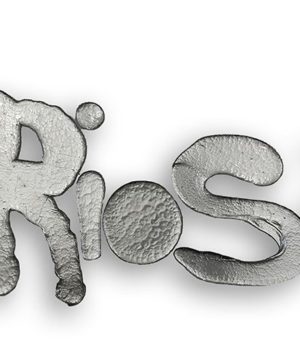Written by Jack Miller
Last Friday, the Olin Gallery unveiled two new exhibits: the calm and tranquil Still(ness) by Roanoke alumnus Duane Cregger, as well as internationally renowned Rob Wynne’s decorative Post Nostalgia. The opening ceremony featured a lecture by Wynne, in which he discussed his work and methods.
Cregger, who graduated from Roanoke College in 1992 with a Bachelor of Arts, currently resides and paints in southwestern Virginia. Still(ness), his latest exhibit, is described by the artist as a “moody search for tranquility within an unruly psyche.” Cregger uses large canvases, oftentimes in close proximity to each other, to contrast their colors, brightness, and overall aesthetics.
Rabbitrine (Diptych), one of his newer pieces (currently on display in Olin), truly conveys the concepts that Cregger is exploring through this exhibit. Through the artist’s use of varying shades of grey, as well as his hard raised lines, he conveys that uncertainty expressed within an unruly psyche. Following his pieces around the upper floor of the gallery, one can see that Cregger’s pieces are fluid, almost like one continuous piece revolving itself in tranquility.
“The paint was not necessarily the focus of the artwork, it more relied on his lines, strokes, and symbols,” said sophomore Erin Pearson.
Cregger’s work has been purchased by fans and displayed in many collections, both public and private, including the actress Drew Barrymore’s private residency.
Wynne’s exhibit, Post Nostalgia, features multiple styles of artwork in varying artistic mediums, many of which feature Wynne’s signature hand poured, mirrored glass. Wynne’s exhibition spans over 25 years of his life and follows a fluid narrative.
“Each work serves as context and springboard for the next,” explained Lilly Wei.
Following the pieces around the room, Wynne’s many phrases captured in mirrored glass catch the eye. The word “curiosity” greets each viewer entering into the gallery, inviting everyone to embrace their curiosity and explore each and every piece in depth. His work echoes themes of literature and visual art history.
Wynne’s many ink spot paintings, which are being displayed in the lower gallery of Olin, use not only reflective glass and shimmering designs but also asymmetry to create the appearance of continuous movement. One student compared some of his more gaseous and liquid-like pieces to Rorschach’s inkblot tests. Wynne’s work is featured in a host of different public exhibits, including The Museum of Modern Art in New York City and Centre Pompidou in Paris, France.
Both Cregger and Wynne’s exhibitions will be displayed in Olin until October 13.




